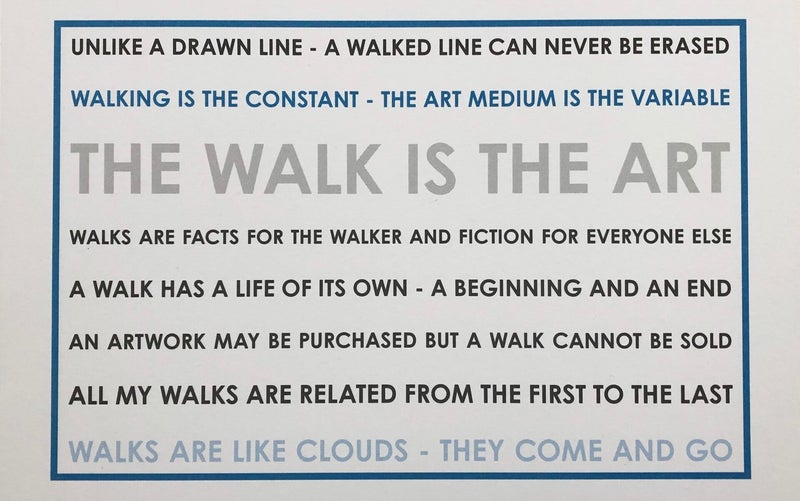"I make walks
and,
materialise my walk texts.
This means that without a walk, there can be no material results.
The weight of the material (things)
may vary from the weight of one paper page in a small note book
to about 6 or 7 kilos for one framed photo text work.
The art works exist
but all of the walks are past events. Each walk has a life of its own. Impermanence.
I am protected by the memories of my walks".
(from: Words from Walks, Courtesy Parafin, 2019)
Leading up to the event held around the English artist Hamish Fulton (1946), being organized May 20 through july 1, 2023 by ARTisBOOK and Galerie Block C in corporation with Peter Foolen (bookdesign, publishing & editions), we are already introducing you his artistry with the beautiful and fascinating work. Fulton no longer has its own website. We hope this page will also fill the void and you will here be informed about the event.
Fulton opts for a direct physical contact with nature and a commitment to the unspoiled landscape. Between 1967 and 1973, Fulton matured the idea of focusing his art exclusively on walks. Fulton himself proclaimed his walks his only true works of art. For Fulton, hiking is an art form in itself and the hikes are invisible objects. During his walks, he takes photographs and numerous short notes. After the walk, the photographs and texts are sparsely incorporated into objects through which Fulton attempts to share his walking experience with the public: drawings, sculptural diagrams, photographs, typographically texts directly to the wall, maps, (graphic) editions, artists' books and -pages, posters and invitation cards. The role of the artist is that of filtering the personal experiences and emotions, giving back to the viewer a synthetic and poetic report.

invitation card, Peter Foolen Editions, Eindhoven, 2015 (photo: © Peter Foolen)
"I transform ideas into experienced realities.
If I do not walk, I cannot make a work of art".
"no walk no work"
"I am not a conceptual artist, retaining ideas within the realm of ideas.
Instead :
I Transform Ideas
Into Physical Experiences".
"Defensively, because in an almost childlike way, I began to notice that walking art
was being categorised by critics and historians as Land Art.
It was as though no one had read the walk texts.
Not a follower of the British Romantics,
not a landscape painter, or a Land Artist..."
From: statement Hamish Fulton, Galerie Thomas Schulte, Berlin, 2021
Coming out of the artistic post-conceptual currents that surged in the mid 1960s, Hamish Fulton’s work is hard to pinpoint. As opposed to other artists whose works centre around nature or landscapes, Fulton establishes a singular relation with the space, leaving no traces of his walks in the work, nor intervening, altering, or aspiring to contain it. This also marks the difference in his practice to those artists attributed to the Land-art movement, for whom the intervention in space and durability were essential characteristics. For Fulton his pilgrimages are symbolic and ritualistic acts that surge from a deep respect for nature.
source: excerpt from the introduction text of the Contemporary Art Gallery 1 Mira, Madrid

